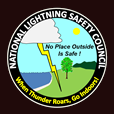
National Lightning Safety Council
- Lightning Safety
Council Home - Lightning
Science - Personal
Safety - Sports and
Recreational Activities - Medical
Information - Lightning
Protection - U.S. Lightning
Fatalities - Lightning Safety
Awareness Week - Resources
Recursos - FAQs
- About/Meet the
Lightning Safety Council - Our
Partners
Protecting Yourself and Your Family - Outdoors
Graphics:
More Information:
Understanding the dangers of lightning is important so you know what to do if a thunderstorm threatens. No place outside is safe when a thunderstorm is in the area. If you hear thunder…even a distant rumble or a crackling aloft…you are already in danger of becoming a lightning victim. Too many people wait far too long to get to a safe place when thunderstorms approach. Unfortunately, these delayed actions lead to many lightning deaths and injuries.
In the United States, there are typically 20-25 million cloud-to-ground lightning flashes every year. Each of those flashes is a potential killer. While lightning fatalities have decreased over the past 30 years, lightning continues to be one of the top storm-related killers in the United States. In addition, lightning injures many more people than it kills and leaves some survivors with life-long health problems.
Lightning can strike more than 10 miles from a thunderstorm, well ahead of any rain, or well after the rain has ended. In fact, many lightning fatalities occur in areas where it is not raining. Summertime leisure activities such as fishing, boating, camping, going to the beach, etc. contribute to about two-thirds of the lightning fatalities with the remainder related to work or routine daily activities.
The best way to protect yourself from lightning is to plan ahead so that you can avoid the lightning threat. You don’t want to be caught outside in a thunderstorm because there is no safe place outside in a thunderstorm. Here are some guidelines that will help keep you safe.
If you are planning an outside activity:
- Have a lightning safety plan.
- Know where you’ll go for safety and how long it will take you to get there.
- Check the weather forecast before heading out.
- If thunderstorms are predicted, consider cancelling or postponing the activity.
- While outside, monitor the weather, and react quickly to changing weather conditions.
- If the sky looks threatening or you hear thunder (even a distant rumble) get to a safe place immediately. Don’t ignore any signs of a developing or approaching storm.
- Remain inside for 30 minutes after the last rumble of thunder.
Substantial buildings and hard-topped vehicles are the safest options. Rain shelters, small sheds, balconies, porches, and open vehicles are not safe.
When lightning strikes a home or building, it often follows the wiring or plumbing to ground. Consequently, you don’t want to be in contact with anything connected to the home’s wiring or plumbing. In addition, the metal components of windows or doors could provide a path for the lightning to enter the home.
Many lightning injuries occur inside.
If someone is struck by lightning, they may need immediate medical attention. Lightning victims do not carry an electrical charge and are safe to touch. Call 911 and monitor the victim. Start CPR or use an Automated External Defibrillator, if needed.
More information: NWS's Lightning Safety for You and Your Family brochure


